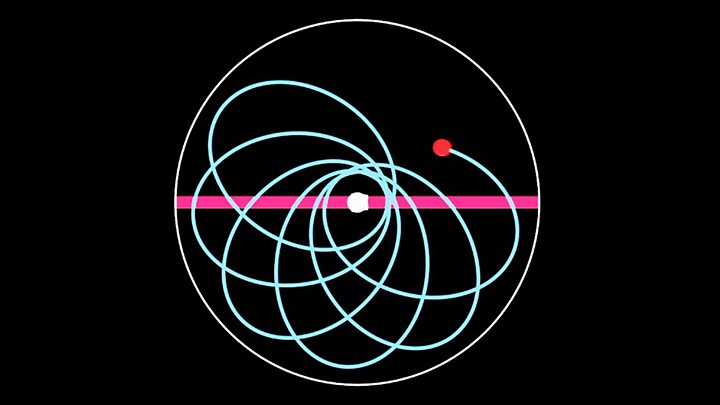
Astronomers have been able to test key consequences of Einstein's theories by studying the way a couple of black holes move around each other.
One of these objects is a true colossus - a hole weighing 18 billion times the mass of our Sun; the other not quite so big at "only" 150 million Sun masses.
Scientists managed to predict their interactions very precisely.
They did so by including their warping effects on space-time and by assuming the larger hole had a smooth "surface".
The black hole pairing, known as OJ 287, exists about 3.5 billion light-years from Earth.
- Hubble delivers stunning 30th birthday picture
- Twisting jet observed at supermassive black hole
- Gravitational waves: So many new toys to unwrap
Scientists have long recognised a sudden brightening from this system that occurs twice every 12 years. The outburst of energy is equivalent to a trillion suns turning on at once in the holes' host galaxy.
The best explanation for this extraordinary behaviour is that the smaller object is routinely crashing through a disc of gas and dust that's accreting on to its larger companion, heating the inspiraling material to extremely high temperatures in the process.
But this flaring is somewhat irregular. Sometimes the brightening episodes in the 12-year period occur as little as one year apart; other times, as much as 10 years apart.

It speaks to the complexity of the path the small hole takes around its partner - a complexity the research team has now built into a highly sophisticated model.
"The orbit of the smaller black hole precesses. That's why the times of the impacts vary," explained Prof Mauri Valtonen from the University of Turku, Finland. "Already back in 1996, we had a model that predicted more or less what would happen. But we've just got more and more accurate," he told BBC News.
One of the updated model's important parameters is the energy radiating away from the system in the form of gravitational waves. These ripples in the fabric of space-time - a consequence of Einstein's theory of general relativity - are generated by accelerating bodies, and in the super-massive circumstances of OJ 287 they have a significant influence on the way the system operates.
The big test of the latest model came on 31 July last year when the appearance of the most recent flaring was identified to within 2.5 hours of what the equations had anticipated.
The event was captured by the US space agency Nasa's Spitzer infrared telescope, a fortunate observation, as it turned out, because OJ 287 was on the far side of the Sun to the Earth at the time and therefore out of sight to ground-based facilities.
Spitzer's separation from Earth (160 million km), on the other hand, put it in prime position.
"When I first checked the visibility of OJ 287, I was shocked to find that it became visible to Spitzer right on the day when the next flare was predicted to occur," said Dr Seppo Laine, a Caltech, US, staff scientist who oversaw the Spitzer viewing.
"It was extremely fortunate that we would be able to capture the peak of this flare with Spitzer, because no other human-made instruments were capable of achieving this feat at that specific point in time."
Another refinement in the model involved folding in details about the larger black hole's physical characteristics. Specifically, its rotation.
Scientists, including the late Stephen Hawking, developed what became known as the "no-hair" theorem of black holes. This essentially states that the surface, or "event horizon", of a black hole along its rotation axis is symmetrical - there are no lumps and bumps.
The observation of OJ 287 is said to be the best test yet of this no-hair idea. If there were serious irregularities, the predicted timing would not have worked out so well.
Prof Achamveedu Gopakumar, from the Tata Institute of Fundamental Research, India, worked on gravitational-wave additions to the model along with graduate student Lankeswar Dey.
The professor spoke of his "elation" on seeing the Spitzer data come through. He is now looking forward to OJ 287 being imaged by the Event Horizon Telescope which produced the first ever picture of a black hole last year.
"The EHT observed the source both in 2017 and 2018. The other campaigns are suspended (because of coronavirus) and we hope to get time during the 2021 campaign," he told BBC News.
Details of the Spitzer observations are published in The Astrophysical Journal Letters.
The next flaring will be in 2022, and then in 2033 and 2034.
Jonathan.Amos-INTERNET@bbc.co.uk and follow me on Twitter.
Source : BBC News - Science & Environment
Dancing gargantuan black holes perform on cue
Dancing gargantuan black holes perform on cue
